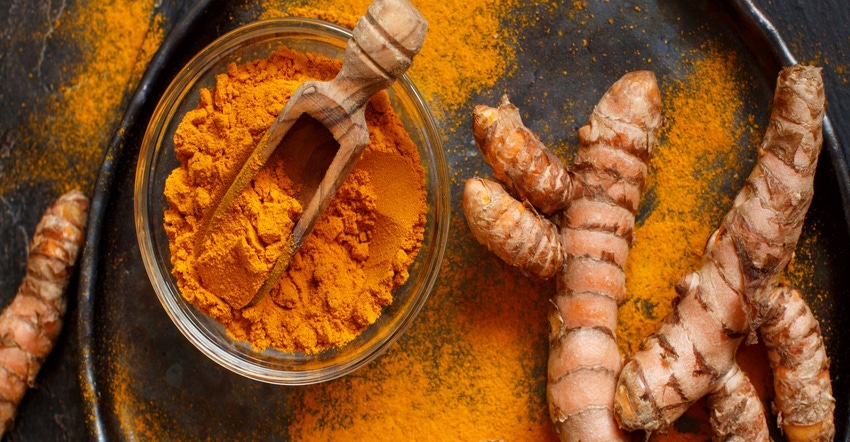Competition has created a crop of curcumin ingredients with high standards beyond the lab, including potential advantages in bioavailability and potency.

Whenever an ingredient reaches “buzzworthy” status, a somber call for calm and the following of proper protocols echo in every Slack chat. Never mind that “these issues are becoming inherent to any active ingredient,” said Laure Egoumenides, product manager at Robertet. “But they are unfortunately emphasized when ingredients have such a high potential.”
As such, curcumin (Curcuma longa, derived from the turmeric plant) finds itself—literally and figuratively—under the microscope. Kristen Marshall, digital marketing manager at Verdure Sciences, explained that part of its popularity is the increase in demand for botanicals “since the onset of COVID, as consumers drive more toward natural and traditionally used supplements.”
The appeal of curcumin comes from an unsexy fact: It works. Sabinsa founder and president Muhammed Majeed, Ph.D., maintained curcumin has “delivered the promised health benefits to millions of people across the globe and earned their trust.”
Benny Antony, Ph.D., joint managing director at Arjuna Natural, said if curcumin is absorbed well, it can boost immunity and help with mood and cognitive support (Br J Nutr. 2016;115[3]:449-465).
“Curcumin supports various health outcomes, flowing beyond known lists,” Antony stated, adding gut health, oral health, skin care and athletic performance as relevant categories. “Curcumin boosts the antioxidant capacity of the body as it neutralizes free radicals on its own and also stimulates the body's antioxidant enzyme” (Nutr Cancer. 2016;68[1]:77-85). This is a great development in the nutraceutical industry’s quest to find what he referred to as a “golden ingredient that could support and manage many more health conditions naturally.” The food and pharmaceutical industries, he suggested, have also taken notice.
Therein lies the rub. Any “golden ingredient” will attract its share of chuckleheads cutting corners in the never-ending quest to make a quick buck. “Adulteration is real, and the adulteration of turmeric is economically motivated,” Majeed pointed out.
Brandon Stolar, sales manager at Indena USA—makers of Meriva, a curcumin phytosome—contended the legitimate curcumin market remains solid with significant competition. “Each company is looking for advantages to stand out in the market. Features such as bioavailability or potency offer differentiation among many options and may be promoted positively or to make a product suspect in the marketplace,” he shared. “While competition is good to grow the market, it’s disreputable when companies take advantage of a growing market to adulterate products.”
On the positive side, competition has created a crop of curcumin ingredients with high standards beyond the lab. Product manufacturers can also choose an ingredient supplier that champions righteous social and business values while delivering real results to consumers. Ingredient integrity is a sure starting point, though.
Majeed and Antony insisted metabolism must be considered to accurately measure the bioavailability of curcumin.
“Bioavailability is to be considered comparing the absorption of free curcumin, which is responsible for the beneficial aspects of curcumin,” Antony said. “The process of metabolism also releases curcumin metabolites, which are inactive.” Arjuna’s BCM-95, a 100% pure turmeric extract, evaluated free curcumin, but Antony explained a lot of companies either don’t mention the number or opt for “an easier method to consider curcumin metabolites.”
The results lead to the consumer getting shortchanged, Majeed held. “Many brands claim several tens of times enhanced bioavailability without a proportionate advantage in health effects, exposing the hollowness in their claims,” he revealed. “Bioavailability is often measured with the wrong methodology. Incorrectly claimed enhanced bioavailability helps to market suboptimal amounts of curcumin. Intestinal effects of curcumin are often ignored, including their beneficial impact on microbiota (J Evid Based Integr Med. 2018;23:1-8). The biotransformation of curcumin into reductive metabolites is invariably glossed over.”
Editor’s note: This article was excerpted from a longer feature in the “Curcumin: Ancient botanical with modern results” digital magazine. Click the link and select “Curcumin: Keeping the buzz going” from the TOC to read it in its entirety.
Pete Croatto was an editor at VRM Inc. from 2003 to 2006 and ran Informa’s Supplement Perspectives blog from March 2011 to January 2015. His writing has appeared in many publications, including The New York Times, Columbia Journalism Review, GQ.com, and AARP the Magazine. His first book, “From Hang Time to Prime Time: Business, Entertainment, and the Birth of the Modern-day NBA,” was released in December 2020.
About the Author(s)
You May Also Like






.png?width=800&auto=webp&quality=80&disable=upscale)